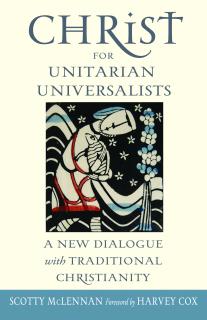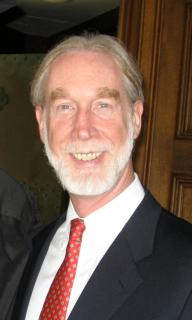Christ for Unitarian Universalists Discussion Guide
Overview
This is a discussion guide for Scotty McLennan’s 2016 Skinner House book, Christ for Unitarian Universalists: A New Dialogue with Traditional Christianity. It is based on a series of seven sessions, but it could be shortened as desired, or any of the topics could be used on a stand-alone basis.
Christ for Unitarian Universalists is a clarion call for UUs—the vast majority of whom don’t identify as Christian—to engage in dialogue with the more than seventy percent of Americans who do so identify. Our tradition has significant continuity with this great historical religion, although that’s often overlooked these days. We also have some ideas about how to enhance the practice and experience of Christianity that traditional Christians today might find compelling.
An adult religious education series on Christ for Unitarian Universalists might have any of these goals: 1) to increase religious literacy about Christianity to help us participate fully in the social, political, and economic life of a nation and world where this religion matters; 2) to understand where Christianity fits within Unitarian Universalism; 3) to elucidate ways that Unitarian Universalist interpretations of the Bible and of Christian history and practice might enrich modern Christianity; 4) to help us talk intelligently with our Christian friends; 5) to envision new ways to engage effectively with Christians in social justice work; 6) to deepen our own personal spiritual lives.
This discussion guide makes recommendations about issues to examine, methods of interaction, and practices to try. Please see it as preliminary and suggestive only, including the way it divides the book into particular sessions.
Session 1: Who Was and Is Jesus, Really?
(Foreword and Introduction, pages ix-xx; Chapter 2, pages 15-29)
Summary: What we know about the historical Jesus comes from the Bible, along with the writings of a couple of non-Christian Jewish and Roman historians of the time. This session provides an opportunity to discuss the most recent scholarly understandings of the pre-Easter man and his times. It also covers aspects of what has been called the post-Easter living Christ, imagined and experienced in myriad ways by billions of people over the two millennia since his death.
Some issues to consider:
1) What changes have occurred in the comprehension of Jesus in the late twentieth and early twenty-first century, given that the majority of Christians no longer live in Europe and the U.S. and we have a South American pope?
2) How useful is it to think of Jesus in two ways, pre-Easter and post-Easter?
3) What could conservative and liberal Christians agree to in a sketch of the pre-Easter Jesus?
Possible way to interact:
- Brainstorm personal images of Jesus and write them all on newsprint. Discuss similarities and differences.
Practice to try:
- Ignatian prayer: Read John 8:1-11 together, a story of how Jesus deals publicly with someone breaking one of the Ten Commandments. Close your eyes and imagine yourself into the story, as the adulterous woman, as Jesus, and/or as the religious authorities in the temple. How does this situation feel emotionally? What sounds do you hear, what do you see, what is going on inside you? Continue to feel your way along in silence for five to ten minutes, without doing any intellectual analysis. Then open your eyes and read the passage aloud together again. Finally, discuss how it felt and what you learned about Jesus in your heart, not your head.
Session 2: What Does It Mean for UUs to Talk About the Living Christ and the Trinity?
(Chapter 1, pages 1-14; Chapter 4, pages 51-65)
Summary: This session examines five ways that current Unitarian Universalists understand Jesus as the living Christ, in the here and now: as imagined or visualized companion, as present in the poor and oppressed, as experienced mystically through a spiritual experience, as being part of the beloved community which is “the body of Christ,” and as living in the Christian story of ongoing death and resurrection. And although the title “Unitarian” was adopted by us in America two hundred years ago to emphasize that Jesus was not and is not God, there may be ways for us to re-image God or ultimate reality now as having more than one face.
Some issues to consider:
1) Is there any way for us as UUs to affirm the bumper sticker “Jesus Lives!”?
2) In what form could UUs adopt the Trinitarian formula of “Father, Son, and Holy Spirit”? As Life Force, Human Love, and Natural Ecology?
3) Can one be fully Unitarian Universalist and fully Christian?
Possible way to interact:
- What stories have you heard about UU Christians? Share around the circle.
Practice to try:
- Close your eyes for five minutes and think about a time when you felt love from or for another person so strongly that it completely transported you outside of yourself. Remember as many details as you can of exactly how this felt. Take another ten minutes to share what you’d like of your memories with the person next to you.
Session 3: Why Should We Celebrate the Christian Holidays of Christmas and Easter?
(Chapter 3, pages 31-49; Chapter 6, pages 83-99)
Summary: Christmas is many UUs’ favorite holiday of the year, and Easter services are among our most well-attended. But we have problems with elements of both stories, as Christians recount them—for example, with virgin birth and singing angels, as well as with bodily resurrection and eternal life. It turns out that each holiday for Christians emphasizes critical dimensions of their faith: in particular, incarnation of spirituality in day-to-day life, and the ever-present possibility of personal transformation for the good. UUs can experience those dimensions, too, in our own way, without the supernatural aspects, perhaps especially through music.
Some issues to consider:
1) What are the “pagan” or nature-centered roots of Christmas and Easter and how do they interact with the Christian stories told in each?
2) Which parts of the Christian stories of Christmas and Easter feel most moving to us as UUs, and how can we translate them into genuine inspiration for others?
3) What could make Christian components of these holidays feel dramatically new or even revolutionary for us, rather than rote and routine?
Possible way to interact:
- Write down on the front and back of an index card an aspect of Christmas and an aspect of Easter that has been important to you in your life. Expand on those aspects with someone in the group you don’t know. Then pass all cards to the front to be read aloud to everyone.
Practices to try:
- Sing Christmas carols together like “Joy to the World,” “O Little Town of Bethlehem,” and “It Came upon the Midnight Clear.” Talk in the group about what’s most personally moving for you in them.
- Sing Easter hymns together like “Jesus Christ Is Risen Today,” “Lo, the Day of Days Is Here,” and “O Day of Light and Gladness.” Talk in the group about what’s most personally moving for you in them.
Session 4: What Are UUs to Think of Miracles and Salvation?
(Chapters 7 and 8, pages 101-125)
Summary: Two traditional Christian views of miracles, from Aquinas and Augustine, are 1) that they are events of God that occur completely outside the order of nature—they are supernatural, or 2) or that nature itself is miraculous in being ordered and reflecting the creative nature of God. A UU dialogue with Christians will proceed most fruitfully by expanding on Augustine’s view. And UUs will be able to talk about salvation most effectively with Christians not by referencing heaven and hell and the afterlife, but instead by considering the ways that we can be saved in the here and now—by finding wholeness, personal fulfillment, and movement toward social justice.
Some issues to consider:
1) How could a Unitarian Transcendentalist like Ralph Waldo Emerson shake the Christian world into a new view of the present reality of miracles?
2) What does modern Christian evangelical universalism look like, and how can we UUs be in conversation with it?
3) What do Christians mean by the Kingdom of God, and why do they pray that “Thy kingdom come, thy will be done, on earth as it is in heaven”?
Possible way to interact:
- Take ten minutes alone to write down ways you have: a) experienced miracles in your life, and b) felt saved. Then share the stories in the larger group, comparing them with what you’ve learned from Chapters 7 and 8 in Christ for Unitarian Universalists.
Practice to try:
- Follow a Zen Buddhist mindfulness exercise by sitting comfortably and quietly for ten minutes. Close your eyes and follow your breath, in and out. Try to empty your mind of all thoughts; when they intrude, let them gently pass through and return to concentration on your breath. Then, discuss with other workshop participants what this experience might have to do with Christian notions of miracle and salvation—particularly in terms of a sense of wonder at the way the natural order works and in terms of trying to live fully in the present moment. Finally, how might we practice wonder and presence in virtually everything else we physically do during the day, how we treat other people, and how we seek to change the world for the better?
Session 5: Could UUs Adopt Martin Luther King Jr.’s Commitment to Social Justice?
(Chapter 5, pages 67-81; Chapter 11, pages 155-161; Chapter 12, pages 163-179)
Summary: Martin Luther King Jr. had freed himself from “the shackles of fundamentalism” by the time he was in college. In pastoring churches in Montgomery, Alabama, and Atlanta, Georgia, he emphasized unconditional love as the centerpiece of Christianity—played out in a commitment to nonviolence and active work for social justice. His understanding of Christianity is one that might be adoptable by Unitarian Universalists. It could help us in learning how to love not only our neighbor but also our enemy, how to be willing to lay down our lives for others in “dangerous unselfishness,” how to face our fears head-on, and how to practice forgiveness.
Some issues to consider:
1) To what extent was Martin Luther King Jr. a religious liberal like Unitarian Universalists, and in what ways did he critique religious liberalism?
2) How can King help us understand the meaning of the central symbol of Christianity, Jesus on the cross?
3) How can we respond to King’s challenge from the Birmingham City Jail: “I have watched white churches stand on the sideline and merely mouth pious irrelevancies and sanctimonious trivialities”?
Possible way to interact:
- Work in small groups of three to four to define carefully what religious liberalism is. Then, in the whole group, discuss how UUs might find common cause with liberal and conservative Christians in social justice work.
Practice to try:
- Consider tithing—giving away one tenth of your pre-tax income to church, charitable, and social justice causes, as Mormons do. Take five minutes to list the positive personal benefits that tithing would bring. Then discuss your ideas with the whole group.
Session 6: How Can UUs Deal with Christian Exclusivism and Triumphalism?
(Chapter 9, pages 127-143; Chapter 10, pages 145-154; Chapter 13, pages 181-198)
Summary: Evangelical Christians often point to two passages in the Gospel of John (3:16 and 14:6)—referring to “only begotten son” and “no one comes to the Father except through me”—to prove that there is no way to God except through Jesus. Yet, both of these passages can be understood in a pluralistic, rather than exclusivist, sense. Christian triumphalism can come with an attitude that leaves no room for doubt, but the Bible is full of stories of faithful doubters like the Apostle Thomas. This session explores ways to open up genuine conversations between Unitarian Universalists and Evangelical Christians.
Some issues to consider:
1) What might be the fullest meaning of Jesus as “the way, and the truth, and the life”?
2) How can traditional Christians understand Jesus with all of their rational faculties intact and with a persistent openness to doubt?
3) What are some practical, concrete methods to bridge the Evangelical-UU divide?
Possible way to interact:
- Think of Evangelical Christians you know personally and how you have interacted with them in relation to your respective spiritual traditions. Talk about your experiences with one or two others. Explain how you might interact differently in the future, given what you have read for this session in Christ for Unitarian Universalists. Bring your best ideas back to the whole group for discussion.
Practice to try:
- Create a brief bread and wine communion service for all present, with an eye to a communal spiritual experience that could genuinely include both UUs and traditional Christians. Include the language that Luke reports Jesus using in his last Passover Seder with his disciples: “He took a loaf of bread, and when he had given thanks, he broke it and gave it to them, saying, ‘This is my body which is given for you. Do this in remembrance of me.’” (22:19) Also Paul’s language when he says, “Because there is one bread, we who are many are one body, for we all partake of the one bread.” (1 Corinthians 10:17) And reference John’s account of Jesus breaking bread with a crowd of five thousand people, many of whom were not his followers: “Jesus took the loaves, and when he had given thanks, he distributed them to those who were seated.” (6:11)
Session 7: How Can Christianity Be Contextualized within UU Pluralism?
(Chapter 14, pages 199-220; Conclusion, pages 221-224)
Summary: UU dialogue about Christ must proceed from a place that is deeply consonant with our own Purposes and Principles. It must meaningfully engage not only traditional Christians, but also humanists, agnostics, atheists, and people identifying with other religious traditions. There are ways to explore notions like God, and like Jesus’s personification of unconditional love, from a pluralistic UU perspective. The metaphor of spiritual pilgrimage might provide a widely acceptable way to think about the search for truth and meaning. Pluralism can be seen as a route to learning about and respecting others’ perspectives without sacrificing personal conscience.
Some issues to consider:
1) Is it broadly acceptable to speak of “God” in terms of infinity, order in the universe, life force, and unconditional love?
2) In what sense could Unitarian Universalists ever talk about Jesus Christ as their Lord and Savior?
3) What does religious pluralism really mean, and what is its relation to coexistence, consensus, and cooperation?
Possible way to interact:
- Take five minutes to think of how you could present a Unitarian Universalist view of Christ to an atheist friend and/or to a friend of a non-Christian religious tradition. Imagine how you would relate to their responses. Then, spend ten minutes explaining your thoughts and feelings to one other person in the group. Finally, contribute what you two find to be most insightful to a general group discussion of parameters for discussion of Christ with non-Christians.
Practice to try:
- Design a way to pursue your own spiritual growth with a Christian dimension within your local congregation. Include relations with your minister(s), other congregants, choir and music program, religious education program, and small group experiences.
Christ for Unitarian UniversalistsA New Dialogue with Traditional Christianity
By Scotty McLennan
An engaging and thoughtful inquiry into Christianity for Unitarian Universalists and other spiritual seekers. Helps to stimulate dialogue about Jesus Christ, whether or not we find him central to our faith life.



